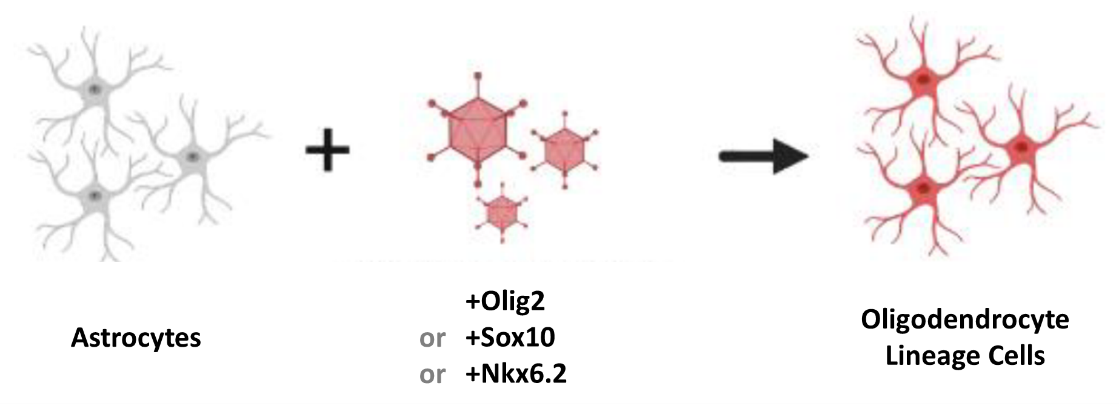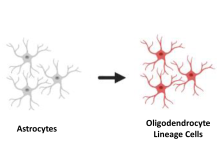BACKGROUND
Loss or dysfunction of oligodendrocyte lineage cells (OLCs) is responsible for a number of central nervous system (CNS) diseases or injuries such as multiple sclerosis, Alzheimer’s disease, cerebral palsy, and spinal cord injury. In addition, the pathological processes of these diseases are often driven by another resident CNS cell, the astrocyte. Direct lineage reprogramming allows for the generation of new OLCs (tissue regeneration) to be paired with the removal of disease promoting astrocyte (disease modifying mechanism). This two birds with one stone approach may result in more functional recovery for disease and injury than either approach alone.
TECHNOLOGY
Researchers at the University of Toronto have generated different types of oligodendrocytes from astrocytes though the ectopic expression of single transcription factors (TFs), namely Olig2, Sox10, and Nkx6.2 (Figure 1). This is of interest because different types of oligodendrocytes are lost in different types and stages of CNS disease and injury. Thus, the ability to produce specific types of oligodendrocytes is key for directed therapeutic interventions. Moreover, this platform enables the removal of specific types of astrocytes that drive disease-specific pathological processes. Moving forward, the overall goal is to develop a platform of precision AAV therapeutics that will allow for the directed conversion of specific astrocytes into specific types of oligodendrocytes, according to disease need.

Figure 1. Conversion of astrocytes to oligodendrocyte lineage cells through use of transcription factors Olig2, Sox10, or Nkx6.2.
COMPETITIVE
COMPETITIVE ADVANTAGE
- Single transcription factors able to induce differentiation of astrocytes into different types of induced oligodendrocyte lineage cells
- Olig2: induced OPCs ~ 16.8% (from Aldh1l1+ astrocytes)
- Sox10: induced OLs ~ 2.8% (from Aldh1l1+ astrocytes)
- Nkx6.2: induced OLs ~ 3.3% (from GFAP+Aldh1l1- astrocytes)
- Astrocytes to oligodendrocyte lineage cells is an attractive therapeutic pathway
- Astrocytes may contain epigenetic marks and active transcription factors that could make DLR faster or more efficient
- Astrocytes are closely related cells that may require fewer TFs for conversion
- Only therapy that addresses the pathological astrocyte
- Does not require immunosuppression
- Does not require transplantation
APPLICATIONS
- Gene therapy for CNS diseases and injury
INTELLECTUAL PROPERTY STATUS
- Provisional filed (April 2023)
PROJECT STATUS
Proof-of-study experiments have been conducted in primary astrocyte cells and in a preclinical model of demyelination. In vitro, the reprogramming potential of Olig2, Sox10 and Nkx6.2 was evaluated using oligodendrocyte lineage markers PDGFRα, O4 and MBP. Lineage tracing, live cell imaging and single cell RNA sequencing were used to demonstrate bonafide astrocyte conversion. Deep learning prediction models validated Sox10 as a strong reprogramming candidate and identified new factors for conversion. In vivo preliminary studies suggest that reprogramming promotes remyelination when delivered in a preclinical model of demyelination.





